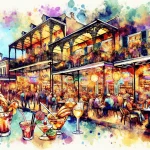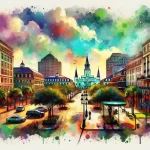Situated along the Mississippi River, just east of the French Quarter, the neighborhood of Bywater, New Orleans has undergone a remarkable transformation in recent years. This historic district has emerged as a vibrant hub for artists, musicians, and food enthusiasts. With its colorful shotgun houses, thriving culinary scene, and unique cultural attractions, Bywater offers visitors an immersive experience into the heart and soul of New Orleans.
In This Article
TL;DR
- Bywater has a rich historical significance and has evolved into a diverse, creative community
- The neighborhood offers a wide array of unique dining experiences, from classic Creole cuisine to innovative fusion fare
- Bywater is a haven for artists, featuring numerous galleries, public art installations, and cultural events throughout the year
Historical Context and Evolution of Bywater
Bywater’s origins date back to the early 19th century when it was primarily a working-class neighborhood populated by immigrants from Germany, Ireland, and Italy. The area was once home to numerous plantations, and the name “Bywater” is believed to have originated from its proximity to the Mississippi River.
Over time, the neighborhood has embraced its cultural diversity, which has greatly influenced its character. The preservation of historical architecture, such as the iconic shotgun houses and Creole cottages, has helped maintain Bywater’s unique charm.
Culinary Scene in Bywater
Bywater’s culinary scene is a reflection of the neighborhood’s rich cultural heritage and innovative spirit. Visitors can savor classic New Orleans dishes like gumbo, po’boys, and jambalaya at local institutions such as The Joint (701 Mazant St, New Orleans, LA 70117) and Elizabeth’s (601 Gallier St, New Orleans, LA 70117).
For an elevated dining experience, Bywater American Bistro (2900 Chartres St, New Orleans, LA 70117) offers Chef Nina Compton’s inventive dishes that showcase local ingredients with a Caribbean twist. The neighborhood’s culinary landscape is also shaped by its proximity to the Mississippi River, with fresh seafood playing a prominent role in many dishes.
Art and Culture in Bywater
Art Galleries and Public Installations
Bywater is a mecca for art lovers, with numerous galleries showcasing the works of local and international artists. The New Orleans Art Center (3330 St Claude Ave, New Orleans, LA 70117) is a must-visit destination, featuring rotating exhibitions and events that highlight the city’s vibrant art scene.
Street art and public installations are also integral to Bywater’s community identity. Visitors can explore the neighborhood’s colorful murals, many of which carry powerful social and political messages. The annual Bywater Fest, held in November, celebrates the district’s artistic spirit with live music, food vendors, and art exhibitions.
Music and Entertainment Venues
A visit to Bywater would be incomplete without experiencing its thriving music scene. Venues like Bacchanal (600 Poland Ave, New Orleans, LA 70117) offer live jazz performances in a relaxed, outdoor setting, complete with a wine shop and delectable small plates. The Spotted Cat Music Club (2372 St Claude Ave, New Orleans, LA 70117) is another popular spot, featuring local and touring acts across various genres, from traditional jazz to funk and blues.
Bywater is also home to several prominent local musicians, such as Jon Cleary, a Grammy-winning pianist and vocalist known for his unique blend of New Orleans R&B, funk, and soul. The neighborhood’s nightlife scene is diverse and lively, with options ranging from cozy dive bars like BJ’s Lounge (4301 Burgundy St, New Orleans, LA 70117) to upscale cocktail lounges like Bacchanal.
Community and Lifestyle
Daily life in Bywater is characterized by a strong sense of community and a laid-back, creative atmosphere. Residents take pride in supporting local businesses, such as the Bywater Community Garden (3308 Chartres St, New Orleans, LA 70117), which provides fresh produce and a gathering space for neighbors.
The neighborhood also embraces a blend of old and new traditions, with events like the annual Mirliton Festival celebrating Bywater’s agricultural heritage, while newer initiatives like the Bywater Bark Park (3000 Royal St, New Orleans, LA 70117) cater to the area’s growing population of pet owners.
Outdoor Activities and Green Spaces
Bywater offers a variety of outdoor activities and green spaces for visitors and locals alike. Crescent Park (2300 N Peters St, New Orleans, LA 70117) is a popular destination, featuring a 1.4-mile linear park along the Mississippi River with stunning views of the city skyline. The park also hosts regular events, such as yoga classes and outdoor movie screenings.
Other notable green spaces include Mickey Markey Park (700 Piety St, New Orleans, LA 70117) and the Bywater Meadow (3700 St Claude Ave, New Orleans, LA 70117), both of which provide ample opportunities for picnicking, sports, and relaxation.
Architectural Styles and Landmarks
Bywater’s architectural landscape is a fascinating mix of styles, from classic shotgun houses and Creole cottages to Victorian mansions and modern developments. The neighborhood’s most iconic landmark is the St. Roch Market (2381 St Claude Ave, New Orleans, LA 70117), a beautifully restored 19th-century market hall that now houses a variety of food vendors and restaurants.
Other notable buildings include the Dr. Bob Folk Art Gallery (3027 Chartres St, New Orleans, LA 70117), housed in a former Bywater corner store, and the Studio Be (2941 Royal St, New Orleans, LA 70117), a massive warehouse transformed into an immersive art experience.
Economic Impact and Development
In recent years, Bywater has experienced significant economic growth and development, largely driven by the influx of new residents and businesses. The neighborhood’s thriving tourism industry has also contributed to its economic success, with visitors drawn to its unique cultural offerings and vibrant atmosphere.
However, this growth has not been without its challenges, as rising property values and rents have led to concerns about gentrification and displacement of long-time residents. Community organizations and local leaders are working to address these issues and ensure that Bywater’s development is sustainable and equitable.
Expert Insights and Future Outlook
As Bywater continues to evolve, local experts and community members are optimistic about the neighborhood’s future. In an interview with a local historian, they emphasized the importance of preserving Bywater’s cultural heritage while embracing new ideas and innovations.
Similarly, a renowned chef in the area spoke about the potential for Bywater’s culinary scene to continue growing and diversifying, with a focus on sustainability and community engagement. Artists and gallery owners also expressed excitement about the future of Bywater’s art scene, predicting an even greater emphasis on public art and community-driven projects.
As Bywater looks ahead, it is clear that the neighborhood’s success will depend on striking a balance between progress and preservation, ensuring that its unique character and vibrant spirit continue to thrive for generations to come.






